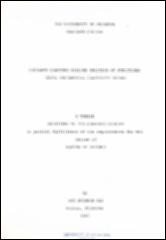| dc.contributor.author | Ali, Mir Shabbar | |
| dc.date.accessioned | 2022-04-01T17:00:13Z | |
| dc.date.available | 2022-04-01T17:00:13Z | |
| dc.date.created | 1987 | |
| dc.date.issued | 1987 | |
| dc.identifier.uri | https://hdl.handle.net/11244/335127 | |
| dc.description | Thesis (M.S.)--University of Oklahoma, 1987. | |
| dc.description | Bibliography: leaves 221-224. | |
| dc.description.abstract | Two computer programs are developed for the finite element analysis of nonlinear elasto-plastic problems, using constant strain-stress triangular elements.
The first computer program predicts initiation and propagation of yielding, and the complete load-displacement history of the structure up to failure due to excessive yielding. The second computer program is an extension of
the first one, and predicts initiation and propagation of yielding, crack initiation, stable and unstable creek growth, ultimate fracture failure load and the complete load-displacement history of the structure up to ultimate fracture failure. The Prandtl-Reuss incremental plasticity equations are used with the von Mises yield criterion in the analytical formulations describing the behavior in the plastic range. Small displacement theory
is considered to be valid.
In the first computer program a small assumed load increment is applied and the strain end stress components are computed for each element. These are used to compute the load increment required to cause yielding of the most stressed elastic element, while the previously yielded elements move along the nonlinear portion of the uniaxial stress-strain curve of the material based on isotropic
hardening plasticity model. Once an element yields, it's elasto-plasticity matrix is used to formulate it's new stiffness matrix. Thus, the analysis is repeated, in cycles, with the application of incremental load in each
load cycle and the computation of the updated system stiffness matrix which depends on the state of stresses and strain of the yielded elements corresponding to the loading acting. The analysis is continued until the incremental
plastic strain becomes negative for any yielded
element, and then the program execution is terminated and the final total load computed is defined as the failure load of the system.
In the second computer program the incremental elasto-plastic analysis is carried out until an element fractures. Before application of any further external load, the internal energy of the fractured element is redistributed to the remaining unfractured system by an "element nodal load release" method developed in this study. If another element fractures during the energy redistribution process of a fractured element, then unstable crack growth is said to occur. The total load at this stage is reported as the ultimate fracture failure load and the program execution is terminated.
A test V-notched tension specimen is considered as a numerical example for verification of the first computer program and a center pre-cracked rectangular panel tension
specimen is considered as a numerical example for verification of the second computer program. The results predicted by the two computer programs compare well with
the results reported in the literature for similar numerical examples. | |
| dc.format.extent | xvii, 250 leaves | |
| dc.format.medium | xvii, 250 leaves : ill. ; 29 cm. | |
| dc.language.iso | eng | |
| dc.subject.lcsh | Structural failures | |
| dc.subject.lcsh | Plasticity | |
| dc.title | Ultimate fracture failure analysis of structures using incremental plasticity theory | |
| dc.type | Text | |
| dc.contributor.committeeMember | Wallace, Benjamin | |
| dc.contributor.committeeMember | Fuzzaman, Musharra | |
| dc.contributor.committeeMember | Rhulineti, A | |
| ou.group | Department of Civil Engineering and Environmental Science | |
